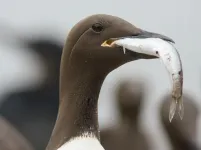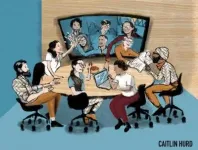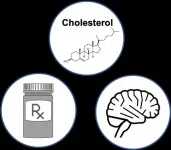(Press-News.org) An estimated one in seven Ohio women of adult, reproductive age has visited a crisis pregnancy center, a new study has found.
In a survey of 2,529 women, almost 14% said they'd ever attended a center. The prevalence was more than twice as high among Black women and 1.6 times as high among those in the lowest socioeconomic group, found a research team from The Ohio State University. Their study appears in the journal Contraception.
Crisis pregnancy centers are often supported by religious organizations and are designed to discourage women with unintended pregnancies from choosing abortion, though they don't typically advertise themselves as anti-abortion. In Ohio, where more than 100 centers are spread throughout the state, they are funded by state dollars. In 2019, during the time of the survey, the state committed $7.5 million over two years to support the centers. Centers that focus on adoption may also receive funding from the sale of "Choose Life" license plates.
Marketed to pregnant teens and women who are trying to make a decision about their pregnancies, the centers typically provide pregnancy testing and counseling and often offer items such as diapers, formula and other baby supplies. Some centers also offer ultrasounds. They are not medical providers, and are not regulated by the Ohio Medical Board.
"Crisis pregnancy centers are visited by a large number of women in general, and even more women from populations that already face serious barriers to reproductive health care, raising concerns that this may serve as another obstacle to medical care," said Robin Rice, the study's lead author and a medical student at Ohio State.
"They look like medical clinics, and some women might not know if it's a medical facility or not," she said.
The new study provides a first-of-its-kind population-level snapshot of the prevalence of interactions with the centers, a measurement that could help clinicians, reproductive rights advocates and others seeking to ensure Ohio women are receiving appropriate medical care, including information about all of their legal options, she said.
Maria Gallo, a study co-author and professor of epidemiology at Ohio State, said that previous research has found that the centers sometimes provide misinformation about reproductive health -- something that is particularly concerning in cases where women mistakenly think they are visiting a health care provider.
"The state is spending millions of dollars on these centers each year, making it even more important that pregnant women are aware of their missions and the fact that they are not medical providers, but typically religious-based outfits that oppose abortion," she said.
"If these centers are drawing in people who don't have other pregnancy counseling and care options, or don't know what those options might be, that's a concern. And if they're doing medically adjacent procedures, like pregnancy tests and ultrasounds, it could increase the chances that women think they're getting regulated health care when they're not."
Gallo said delays in getting medical care could result in women not receiving a proper diagnosis of early pregnancy complications such as life-threatening ectopic pregnancy.
Rice said it's important that health care providers understand the reach of these centers, and recognize that their patients' experiences may be colored by information they receive at them. Another potential action item based on the study's results: "We could seek to establish legitimate state-funded prenatal clinics in those areas that may not have them," she said.
"Mitigating financial barriers is also important. Crisis pregnancy centers are free, so we might also want to think about ways to offer alternative free support services that also draw women in for comfort and to get free supplies."
From a policy perspective, Gallo said lawmakers may want to rethink the use of state funds for unregulated organizations that have been shown to provide health misinformation.
INFORMATION:
Other Ohio State researchers who were part of the study team are Payal Chakraborty, Lisa Keder and Abigail Norris Turner.
CONTACTS: Robin Rice, Robin.Rice@osumc.edu; Maria Gallo, Gallo.86@osu.edu
Written by Misti Crane, 614-292-3739; Crane.11@osu.edu
Local management of coral reefs to ease environmental stressors, such as overfishing or pollution, could increase reefs' chances of recovery after devastating coral bleaching events caused by climate change, a new study finds. The results suggest that caring for reefs on a local scale might help them persist globally. When waters warm, corals can die quickly and en masse in coral bleaching events. Marine warming due to climate change has resulted in sharp increases in both the frequency and magnitude of these mass mortality events, which have already caused severe ...
An exoskeleton can reduce the metabolic cost of walking not by adding energy or by recycling energy from one gait phase to another, as other exoskeletons have done, but by removing the kinetic energy of a striding person's swinging leg so they don't have to tense their muscles so much. Tested in ten healthy males, it also converted the extracted kinetic energy to useable electricity. Although humans are exceptional walkers, walking is metabolically expensive and requires more energy than any other activity of daily living. Exoskeletons and exosuits - wearable devices designed to work along with the body's musculoskeletal system - have been shown to reduce this cost by adding or recycling energy to assist the body's movement. These and other ...
There is heightened public awareness that the world's oceans are under duress, with over-fishing and plastic pollution as some of the more tangible problems. Now, seabirds are calling attention to another problem and have delivered a warning message.
Serving as translators of the birds' message, an international team of 40 scientists led by William Sydeman at the Farallon Institute in northern California published findings on May 28 in the journal Science that some seabirds are struggling to raise young where the globe is most rapidly warming - in the northern hemisphere.
Using over 50 years of data from 67 seabird species across the globe, the team found ...
In a study that uniquely evaluates marine ecosystem responses to a changing climate by hemisphere, researchers report that the fish-eating, surface-foraging bird species of the Northern Hemisphere suffered greater breeding productivity stresses over the last half-century than their Southern Hemisphere counterparts. The findings suggest the need for ocean management at hemispheric scales and underscore the importance of long-term seabird monitoring programs - some of which are already under threat - by illustrating the critical role that seabirds play as sentinels of global marine change. To date, global understanding of ocean change has not explicitly considered differences, ...
Australian researchers recently reported a sharp decline in the abundance of coral along the Great Barrier Reef. Scientists are seeing similar declines in coral colonies throughout the world, including reefs off of Hawaii, the Florida Keys and in the Indo-Pacific region.
The widespread decline is fueled in part by climate-driven heat waves that are warming the world's oceans and leading to what's known as coral bleaching, the breakdown of the mutually beneficial relationship between corals and resident algae.
But other factors are contributing to the decline ...
HOUSTON - (May 27, 2021) - One hundred fifty years ago, Dmitri Mendeleev created the periodic table, a system for classifying atoms based on the properties of their nuclei. This week, a team of biologists studying the tree of life has unveiled a new classification system for cell nuclei and discovered a method for transmuting one type of cell nucleus into another.
The study, which appears this week in the journal Science, emerged from several once-separate efforts. One of these centered on the DNA Zoo, an international consortium spanning dozens of institutions including Baylor College of ...
Many seabirds in the Northern Hemisphere are struggling to breed -- and in the Southern Hemisphere, they may not be far behind. These are the conclusions of a study, published May 28 in Science, analyzing more than 50 years of breeding records for 67 seabird species worldwide.
The international team of scientists -- led by William Sydeman at the Farallon Institute in California -- discovered that reproductive success decreased in the past half century for fish-eating seabirds north of the equator. The Northern Hemisphere has suffered greater impacts from human-caused climate change and other human activities, like overfishing.
Seabirds include albatrosses, puffins, murres, penguins and other birds. Whether they ...
A new paper, published recently in PLOS Computational Biology by a team including UMass Amherst researchers, seeks to help scientists structure their lab-group meetings so that they are more inclusive, more productive and, ultimately, lead to better science.
The word "scientist" might conjure images of lab-coated researchers tending bubbling beakers or building supercomputers, but an enormous amount of scientific work takes place around a conference table during weekly group meetings. "There is plenty of good research showing that diversity and inclusion make the science itself better," says Kadambari Devarajan, one of the paper's co-lead authors and a graduate ...
The blood-brain barrier is impermeable to cholesterol, yet high blood cholesterol is associated with increased risk of Alzheimer's disease and vascular dementia. However, the underlying mechanisms mediating this relationship are poorly understood. A study published in the open-access journal PLOS Medicine by Vijay Varma and colleagues at the National Institute on Aging, part of the National Institutes of Health, in Baltimore, Maryland, suggests that disturbances in the conversion of cholesterol to bile acids (called cholesterol catabolism) may play a role in the development of dementia.
Little ...
Quantum systems are considered extremely fragile. Even the smallest interactions with the environment can result in the loss of sensitive quantum effects. In the renowned journal Science, however, researchers from TU Delft, RWTH Aachen University and Forschungszentrum Jülich now present an experiment in which a quantum system consisting of two coupled atoms behaves surprisingly stable under electron bombardment. The experiment provide an indication that special quantum states might be realised in a quantum computer more easily than previously thought.
The so-called decoherence is one of the greatest enemies of the quantum physicist. Experts understand by this the decay of quantum states. This inevitably occurs when the system interacts with its environment. In ...




